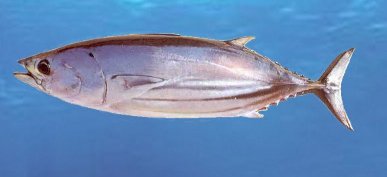
Skipjack Tuna are not only found in New Zealand waters, they occur worldwide in warm seas. They are a highly migratory, oceanic pelagic fish that inhabits tropical and subtropical seas.
They are found throughout the eastern Pacific. Skipjack usually visit California waters in the Autum and winter months where water is relatively warm (about 68° F or 20 celsius).
Skipjack tuna are a schooling fish and also having a general tendency to school by size.
The body of the skipjack is cigar-shaped (tapers at both ends). The snout is sharply pointed and the mouth is relatively large. These tuna have fine, slender teeth, a strong median keel on the caudal fin base between two small keels, and barely separated first and second dorsal fins.
As with other Tuna the Skipjack are built for speed, as evidenced by their sleek, stream lined bodies and powerful, deeply forked tails.
The color is dark blue to purple on the back and becoming silvery or white below, with four to six dark longitudinal stripes on the belly.
The depth range of skipjack tuna can be from surface waters to 260m during the day, but at night it is much shallower.
They enter coastal waters to feed. The diet of the skipjack tuna includes small fish such as anchovies and sardines as well as squid. A 3 pound Tuna can eat up to 31 percent of its weight per day in food.
Peak feeding occurs early in the morning and again late in the afternoon.
Skipjack tuna are thought to spawn off northern Queensland and in waters off north western Australia. In equatorial waters spawning occurs during all months, but in sub-tropical waters the season is restricted to summer and early autumn.
A skipjack tuna's average length in New Zealand is 45 - 60 cm, or 1.5 to 2 ft, reaching about 70 cm, or 2ft 3in, but larger in other parts of the world, reaching over 100 cm, or a little over 3ft. Weights average 2.5 kg or 5.5lbs for a 50 cm fish, 8 kg at 70 cm.
They lay an estimated 113,000 eggs, while one that is 22.1 inches long and weighs around 13lbs produces up to 600,000 eggs.
The young fish grow rapidly and when 1 year old are 18 inches long. They rarely live beyond 7 years.